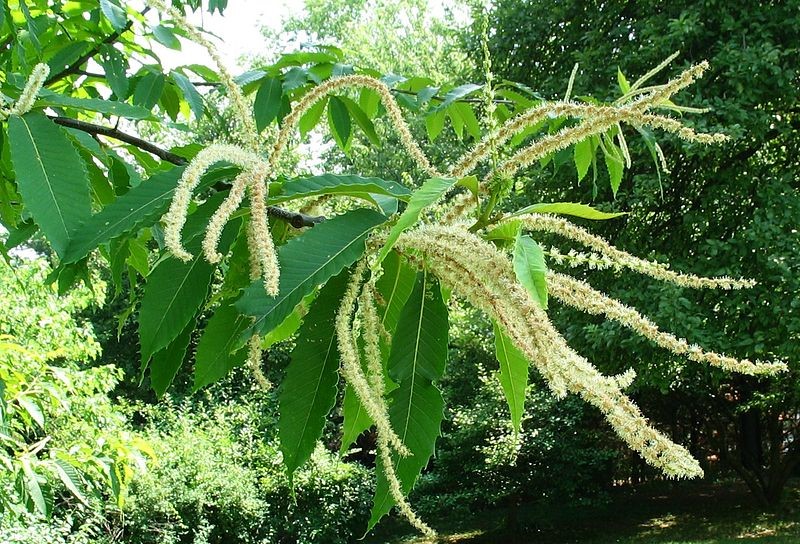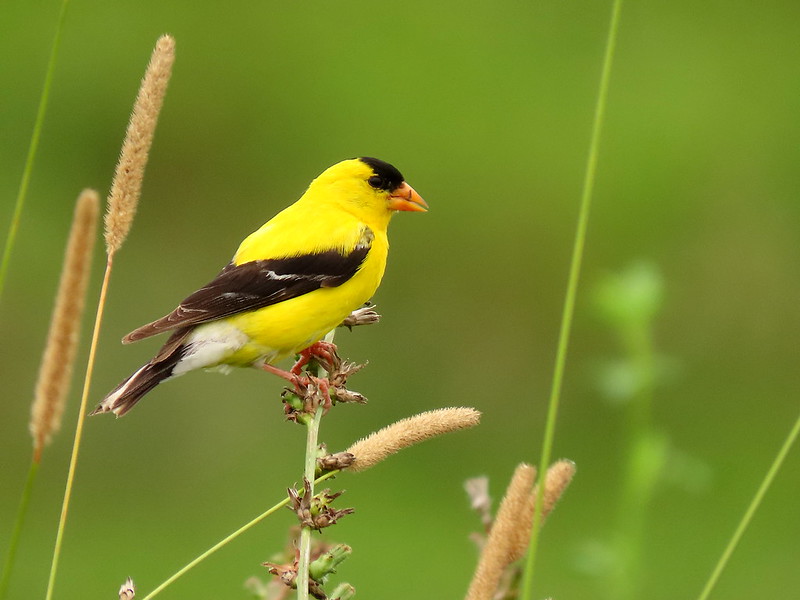In preparing for a monthly guided nature walk recently, I was reminded that things happen in their own time. Just two months ago, we were listening to bird songs from migrants that just returned north and admiring the fresh green of newly unfurled leaves. One month ago, we peeked at bird nests in Audubon’s next boxes. In July, our thoughts turned towards the abundance of insects. We also looked for shady spots under full spreads of tree canopies. Summer is the season where trees are collecting as much sun as possible to fuel their food-making. Done flowering, and with a full complement of green leaves, this is the time for growing before the dormancy of winter.

But not all. Later that week I saw chestnut tree in full bloom. The pollen-loaded catkins dangled among the leaves like streamers at a party. Given the closeness of the Fourth of July holiday, they also reminded me of fireworks, frozen in time. This is the time for chestnuts to bloom in our New York and Pennsylvania region. It seems late in the season for trees to bloom. But things happen in their own time.
Red Maple and willow trees bloom early — usually late March and April — and are an early food source for pollinating insects. Then it’s a quick parade of other tree flowers. I’ve tried to note the order of this show. Next the pines, their pollen leaving a yellow dusting wherever it lands. Tulip Poplars with their showy yellow and orange would fall somewhere in the middle as would Sassafras and cherries.
Who would be last? Oaks would be toward the end. Black Locust too. I remember munching on their pea-shaped flowers at the Allegheny Nature Pilgrimage in Allegany State Park the weekend after Memorial Day each year. I also recall standing under the shade of a huge Northern Catalpa tree at a summer camp. The flower petals were falling on us as we waited for the first summer campers to arrive. But I think chestnuts — Chinese and the blighted American — would bring up the rear.
Why are these flowers so spread out in their bloom time? I presume it is to reduce competition. As a tree, your pollen is more likely to reach its destination, via wind or animal pollinators, if it doesn’t have to share space with others; if it waits its turn.
Frogs are the same way. Not all frog species call at once. Starting with the Wood Frog and Spring Peepers, frogs spread out their calls throughout the spring and summer, ending with the deep summer roars of the Bullfrog.
Recently, I was listening to friends chat as we carpooled. As we cruised past patches of Staghorn Sumac — another late blooming tree — they shared their worries for their children. One was slow to pick up writing and academics and smaller than other kids. Another one concerned her daughter had no idea what she wanted to be when she grew up. And maybe she wasn’t mature enough. Perhaps just like trees, we all bloom in our own time. I love the book Leo the Late Bloomer written by Robert Kraus and illustrated by Jose Aruego. In this story, Leo isn’t picking up on reading, drawing, or speaking as quickly as his peers. Not to spoil the end but Leo, who is an adorable tiger, eventually comes into his own.
I’ve always identified with Leo. I’ve always felt a little behind, not accomplishing big life things, not quite catching on to how things worked when I was “supposed to”. But perhaps I was not just waiting my turn but also waiting for the right pairing.

The American Goldfinch is one of the latest nesting birds in our area, not nesting until July or August. At this point in the summer most other songbird nestlings have fledged and are feeding on their own. But goldfinches do things in their own time. And there’s a reason. They time their mating with thistle plants going to seed. Goldfinches use thistle fluff to build their nests and thistle seeds, as well as other seeds, to feed their young.
I hesitate to make too many comparisons between our human struggles and nature’s. But I find comfort in knowing there are late bloomers that survive just fine. And their timing of things is intentional. Some may say they are late. Others may say they are right on time.
Katie Finch is a naturalist at Audubon.
Audubon Community Nature Center builds and nurtures connections between people and nature. ACNC is located just east of Route 62 between Warren and Jamestown. The trails are open from dawn to dusk as is Liberty, the Bald Eagle. The Nature Center is open from 10 a.m. until 4:30 p.m. daily except Sunday when it opens at 1 p.m. More information can be found online at auduboncnc.org or by calling (716) 569-2345.


Recent Comments